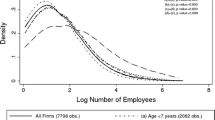Abstract
Restricted access to finance (either debt or equity or both) is potentially a significant constraint on the growth of small businesses. Financing problems arise primarily as a consequence of information asymmetries; the adverse effects of these may in part be counteracted by the use of collateral as a signalling and bonding mechanism and/or by the development of a good working relationship between lender and borrower. If the form of information asymmetry differs for growth firms or if the effects of information asymmetries are less easily ameliorated then growing firms may be more adversely affected by credit constraints. If growth is contingent upon access to credit then the generalised implications for the economy may be significant and detrimental. Using evidence from a survery of over 6,000 firms conducted in 1992, this paper addresses the extent to which growth firms are adversely affected by a credit constraint; the results suggest that the credit constraint for growing firms per se is no greater but growth firms may still experience a credit constraint as a consequence of their relative youth. However, there is evidence to suggest that firms expecting to grow in the future do perceive a rather tighter credit constraint but this may be partly or wholly offset by a generally better relationship with their bank.
Similar content being viewed by others
References
Berger, A. N. and G. F. Udell, 1989, ‘Lines of Credit, Collateral and Relationship Lending in Small Firm Finance’, Working Paper (S-93/17), Salomon Brothers Center for the Study of Financial institutions, New York University.
Berger, A. N. and G. F. Udell, 1993, ‘Lines of Credit,Collateral and Relationship Lending in Small Firm Finance’, Working Paper (S-93/17), Salomon Brothers Center for the Study of Financial institutions, New York University.
BesterH., 1987, ‘The Role of Collateral in Credit Markets with Imperfect Information’, European Economic Review 31, 887–899.
BesterH. and M.Hellwig, 1989, ‘Moral Hazard and Equilibrium Credit Rationing: an Overview of the Issues’, in G.Bamber and K.Spremann (eds.), Agency Theory, Information and Incentives, Berlin: Springer-Verlag.
BinksM. R., C. T.Ennew and G. V.Reed, 1988, ‘The Survey by the Forum of Private Business on Banks and Small Firms’, in G.Bannock and E.Victor Morgan (eds.), Small Businesses and Banks: A Two Nation Perspective, Knutsford, Cheshire: Forum of Private Business.
BinksM. R., C. T.Ennew and G. V.Reed, 1990, Small Businesses and their Banks, Knutsford, Cheshire: Forum of Private Business.
BinksM. R., C. T.Ennew and G. V.Reed 1993, Small Businesses and their Banks, Knutsford, Cheshire: Forum of Private Business.
BinksM. R. and C. T.Ennew, 1994, Small Businesses and their Banks (Reports 1&2) Knutsford, Cheshire: Forum of Private Business.
Bolton, J., 1971, Small Firms, Report of the Committee of Inquiry on Small Firms, HMSO Cmnd 4811.
deMezaD. and D. C.Webb, 1987, ‘Too Much Investment: A Problem of Asymmetric Information’, Quarterly Journal of Economics 102, 281–292.
Dempsey, M. and K. Keasey, 1993, ‘Small Firms and the Provision of Bank Finance’, Accounting and Business Research.
KeaseyK. and P.McGuiness, 1990, ‘Small New Firms and the Return to Alternative Sources of Finance’, Small Business Economics 2, 213–222.
KeaseyK. and R.Watson, 1992, ‘Investment and Financing Decisions and the Performance of Small Firms’, London: National Westminster Bank.
KeaseyK. and R.Watson, 1993, Small Firm Management, Oxford: Basil Blackwell.
MasonC. M. and R.Harrison, 1991, ‘The Small Firm Equity Gap Since Bolton’, in J.Stanworth and C.Grey (eds), Bolton 20 Years on: the Small Firms in the 1990s, London: Paul Chapman Publishing.
Macmillan, H., 1931, Report of the Committee on Finance and Industry, HMSO, Cmnd 3897.
Radcliffe, 1959, Report of the Committee on the Working of the Monetary System, HMSO, Cmnd 827.
SharpeS. A., 1989, ‘Asymmetric Information, Bank Lending and Implicit Contracts: A Stylized Model of Customer Relationships’, Finance and Economics Discussion Series no 70, Federal Reserve Board, Washington, May.
StoreyD. J., 1994, Understanding the Small Business Sector, London: Routledge.
StiglitzJ. and A.Weiss, 1981, ‘Credit Rationing in Markets with Imperfect Information’, American Economic Review 71, 393–410.
Wilson, H., 1979, The Financing of Small Firms, Report of the Committee to Review the Functioning of Financial Institutions, HMSO Cmnd 7503.
Author information
Authors and Affiliations
Rights and permissions
About this article
Cite this article
Binks, M.R., Ennew, C.T. Growing firms and the credit constraint. Small Bus Econ 8, 17–25 (1996). https://doi.org/10.1007/BF00391972
Accepted:
Issue Date:
DOI: https://doi.org/10.1007/BF00391972




